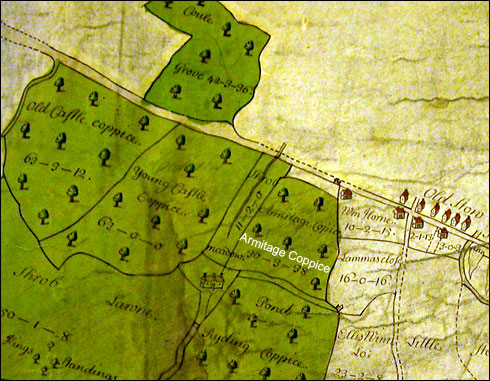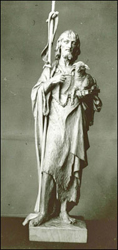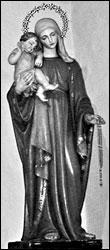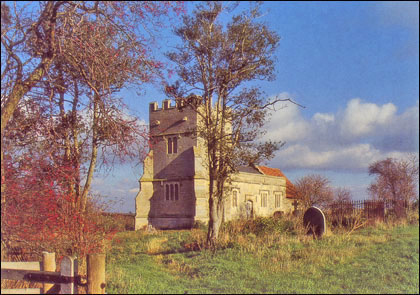 |
|
 |
Old Stratford - The Hermitage & Chapel of St. John
Although the hermitage was certainly part of the former Broughton lands forfeited by Howard to the Crown, it appears not to have been included in the grant to Paulet of 1548, for in 1562 Cecily Pickerell was granted the site, grounds and precincts of the chapel or hermitage, containing five bays of building, an orchard, an acre of meadow, a rood of pasture and 4½ a. arable, to hold in free socage. Cecily was the widow of John Pickerell, treasurer to Edward duke of Somerset, and the grant was made in part repayment of debts due to her husband at the time of Somerset's execution in 1552, when it was enacted that his debts should be satisfied out of the issues of his lands which came to the Crown when he was attainted. This possibly suggests that the hermitage estate had briefly been held by Somerset. Mrs. Pickerell appears to have sold the house and land to George Ferne, who in turn sold the premises to Thomas Furtho, whose son Edward died in 1620 seised of the hermitage or free chapel of Old Stratford, its site and precincts, including land in Old Stratford, Cosgrove, Passenham and Furtho, which his father Thomas had purchased from George Ferne. The premises were valued at 2s. a year. His son, also Edward Furtho, died the following year holding the same estate, which was then divided between his two sisters. In 1610 the Crown sold to Thomas Ely and George Merriell of London several pieces of land said to lie within Whittlewood Forest, and also what was described as the Hermitage House with garden, orchard and curtilage, and six closes of land, containing 186 a. in all, of which five, valued at 14s. 2d. a year, lay together and were known as the Hermitage Close or Hermitage Grounds, and the sixth, worth 10s., was called Carlton Sart. The Crown had recently recovered the premises as assarts and purprestures in Whittlewood from Otho Nicholson. Ely and Merriell later sold this estate to Edward Furtho, who was the owner at the time of his death in 1620. A late 16th-century description of the boundary of Furtho parish, evidently copied from an earlier account, locates the hermitage immediately to the north of the main road on the western edge of Old Stratford, and describes the adjoining land on the Furtho side of the boundary with Cosgrove as belonging to the hermitage. A perambulation of the bounds of the manor of Passenham of much the same date also places the hermitage close to Watling Street near the brow of the hill, and in 1566 the manor included a close in Old Stratford in the tenure of Thomas Furtho, 'late appurtenant to the Hermitage'. A terrier of 1504 names a piece of land in the same area as the 'Armites Half Acre' or 'Armitis Half', which lay within Quarry Field, one of the common fields of Cosgrove and Furtho, in which Hermitage Meadow was another landmark in the early 17th century. There was also a Chapel Furlong in the same area, while the woodland on the opposite side of Watling Street, near Shrobb Lodge, was called 'Armitage Coppice'. As late as 1849 there was a field at Old Stratford known as Chapel Close, which was said to be the site of the hermitage and chapel. This cannot apparently be located but the 16th-century references place the buildings at or very close to the site later occupied by Furtho Rectory Farm, implying that at some date after 1621 the hermitage lands became part of Furtho glebe. The farm buildings were demolished soon after Furtho glebe was sold in 1921. |
||||||
|
||||||
|
|
||||||
| Victoria County History Northamptonshire
The Free Chapel of St. John. A chapel associated with the hermitage which stood on Watling Street at the northern end of Old Stratford appears to be first mentioned in a pontage grant of 1352. In 1376 John Goodrich purchased a third of the manor of Puxley and a third of the advowson of the chapel of Little Stratford from Richard Hartshill and Isabel his wife, and in 1494 the hermitage received a bequest of 12d. from Thomas Pesenest of Stony Stratford.
During the period in which the hermitage estate was held by the Crown in the early 16th century, the rector of Furtho, Thomas Ball, was accused of removing from the chapel vestments, furnishings, and images of the Virgin, St. John and another saint. His answer was that the chapel lay within his parish, that the patron of Furtho was also patron of the chapel, and that the rector of Furtho, before the dissolution of the hermitage, was accustomed to say mass at the chapel at certain times of the year, when a chalice, vestments and ornaments were taken from the parish church (to which they belonged) to the chapel but always returned afterwards.
The patron of Furtho had removed a bell and the three saints' images from the chapel to the parish church, but only to save them from theft. He claimed to know nothing about the disappearance of an alabaster altar from the chapel. |




